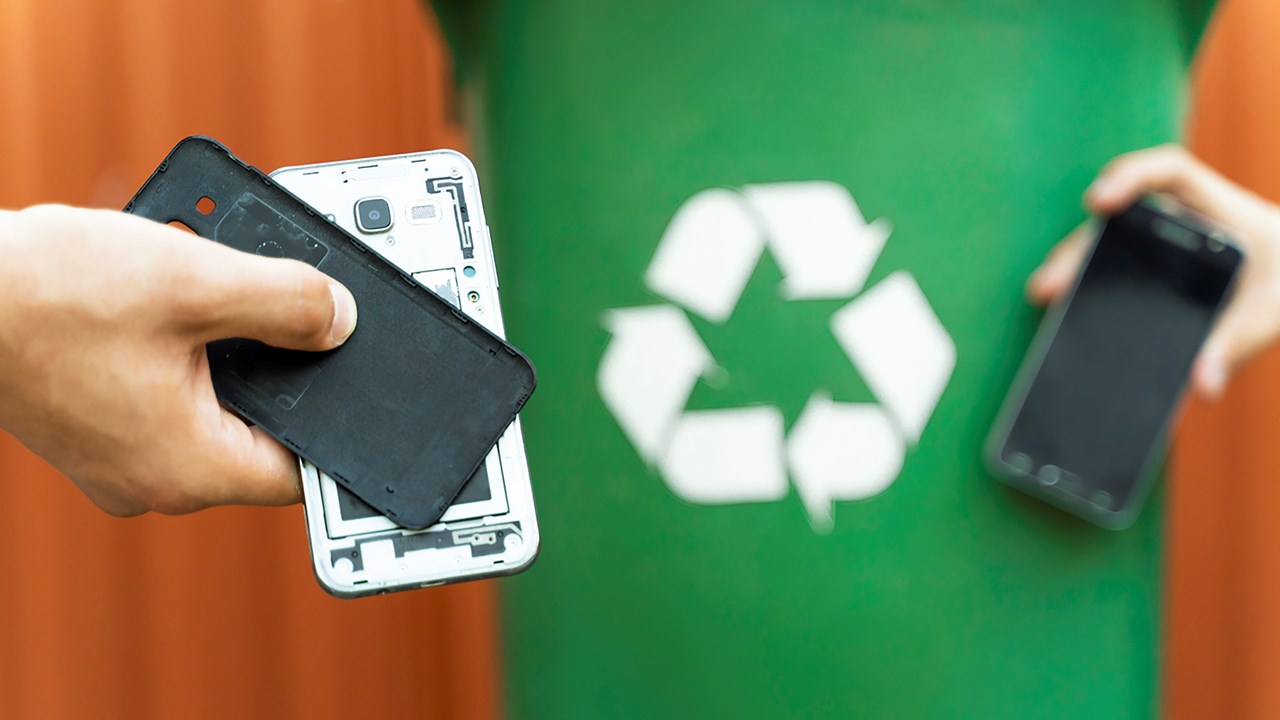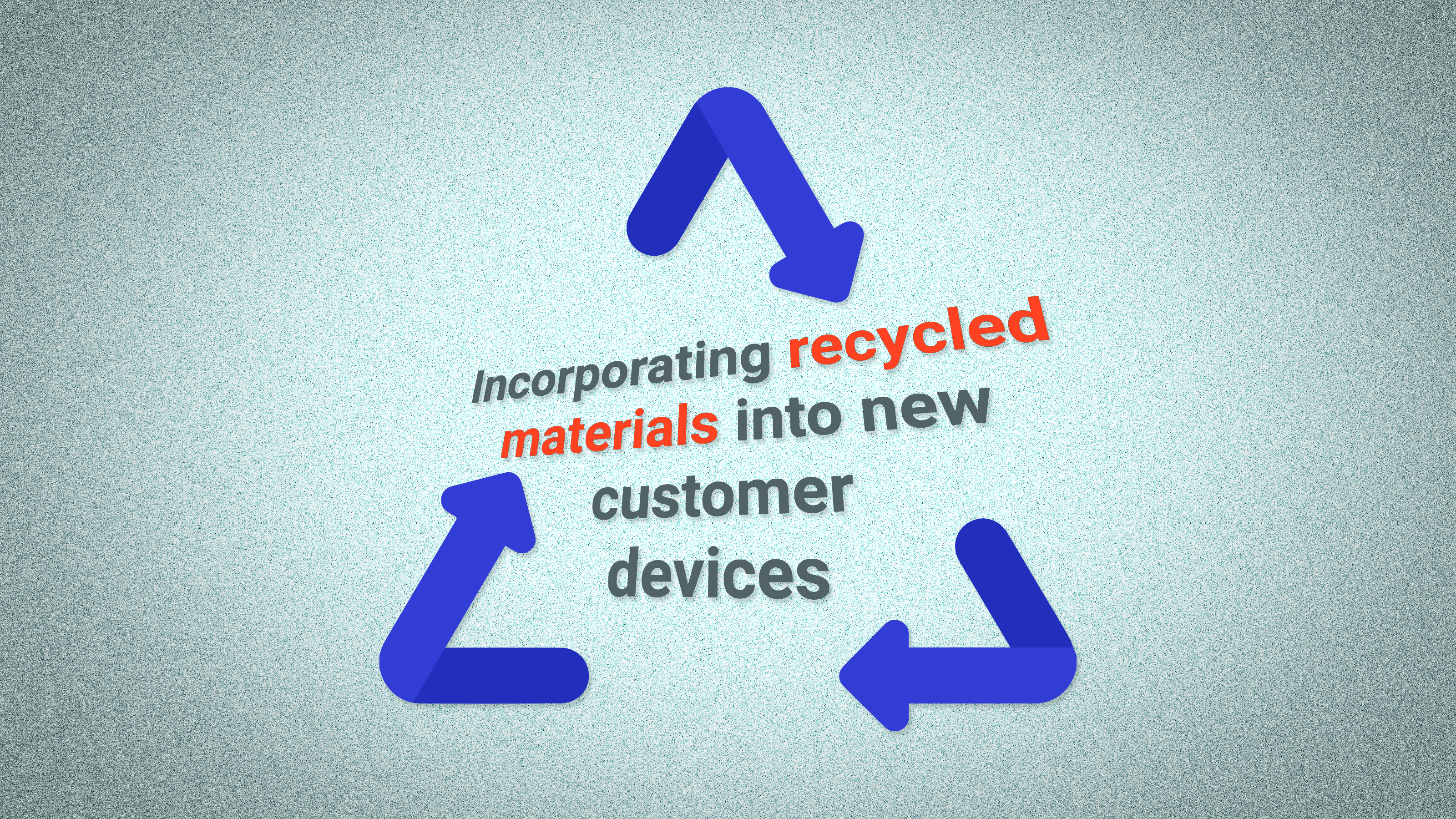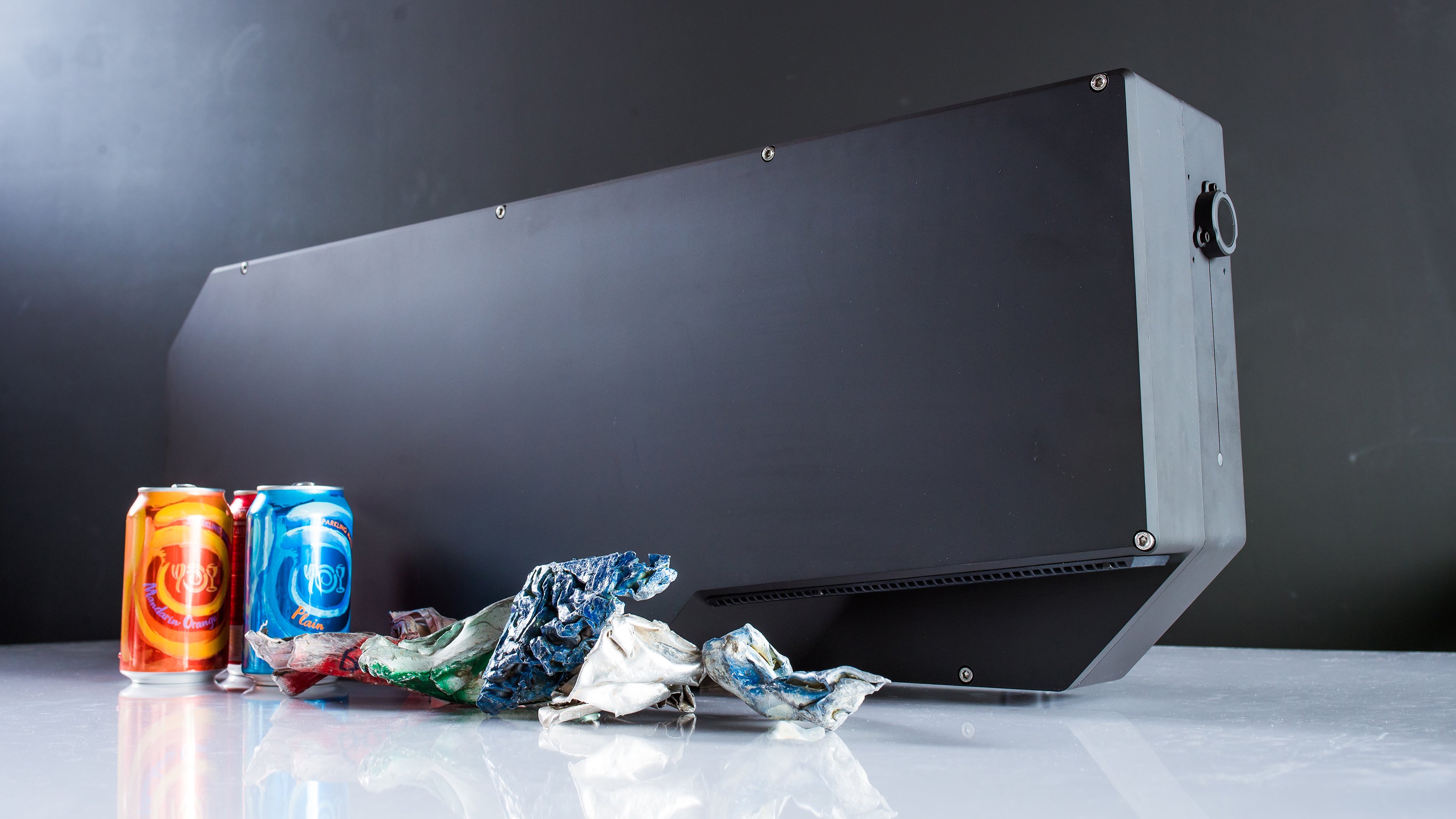Subscribe to Our Blog
Receive updates from our team as we share application notes, customer spotlights, educational tools, spectroscopy how-to’s, and more.

Businesses have launched sustainability initiatives to reduce their carbon footprint, minimize waste and encourage materials reuse and recycling. Here’s how optical sensing technologies play a key role in these efforts.
IMPORTANT: PLEASE REFRESH YOUR BROWSER IF YOU DO NOT SEE ANY IMAGES ON THE PAGE.
Inspired by a growing awareness of the consequences of climate change, an acknowledgement of the fragility of the environment and an anticipated scarcity of vital resources, companies from automakers to tech giants are taking steps to be more responsible corporate citizens. This movement echoes the changing attitudes of customers, who are rewarding companies that invest in sustainability efforts with their patronage and brand loyalty.
For example, among the companies embracing sustainability targets is Apple, which has pledged to achieve carbon neutrality across its entire manufacturing chain by 2030; The Coca-Cola Company, which has targeted 100% recyclable packaging by 2025; and Microsoft, which reported 18% reduction in single-use plastics in its packaging in 2021 and has pledged zero waste by 2030.
Technology is a vital element of successful sustainability efforts, especially in resource management and recycling efforts. This is where Ocean Insight and its brands have become valuable partners both to materials researchers and to industrial customers, whose mantra to “reduce, reuse, recycle” creates challenges – and opportunities -- along the path to sustainability.
In this article, we will focus on the powerful optical sensing technologies that help industry to recycle metals, plastics and other materials more effectively.
Company Background
Environmental stewardship is part of Ocean Insight’s heritage. Our first product was a fiber optic pH sensor deployed at sea to measure pH and investigate its correlation to rising carbon dioxide levels, and our spectral sensing products have been part of eco-friendly efforts ranging from development of precision agriculture techniques to promotion of renewable energy resources. Closer to home, we’ve taken steps across our worldwide facilities to lessen our own carbon footprint, reduce waste and integrate greener materials into packaging.
Today, Ocean Insight comprises three industry-leading photonics brands: Ocean Optics, which pioneered compact spectrometers and delivers spectral solutions to researchers and industrial customers; Ocean Applied, which designs and builds industrial-grade systems for material analysis and quality assurance; and International Light, which supplies lighting and light measurement solutions. Through these brands, we support customers worldwide that develop and utilize technologies to monitor the environment, ensure the quality and availability of critical natural resources, and analyze materials to improve quality and reduce waste.
Sustainability initiatives often have lofty goals, but with modern sensing technology as part of the strategy, these targets are achievable. As one of our customers phrased it, if science is our way of understanding how to live within our ecological means, then technology is here to help us make the best of the opportunity.
Nothing embodies that sentiment more than the concept of a circular economy.
Technology and the Circular Economy
There may be as many definitions of a circular economy as there are strategies to make such an economy viable. At its simplest, a circular economy incentivizes the reuse of products to prevent them from ending up in a landfill or polluting the environment. This reuse also lessens the strain on the energy and resources necessary to make new products from virgin (i.e., previously unprocessed) materials.
Circular economy models apply across every industry sector. Indeed, according to various industry and government reports, up to 60% of businesses today have sustainability strategies, with emissions reduction and sustainable (recyclable) products frequently cited as important pillars of those strategies.
With that in mind, let’s home in on the recycling stage of the circular economy. This is where optical sensing strategies play a role in a) ensuring accurate sorting and processing of recyclable materials such as metals, glass and plastics, and b) analyzing the quality of new products that can be remade from those materials.

Spectral sensing technologies are ideal for materials analysis. These techniques are non-destructive or minimally invasive, can be configured into instruments to make measurements rapidly, and are easily integrated into recycling operations. Sensing technologies have become more powerful and robust, making them suitable for use in what are typically very demanding environments, subject to temperature extremes, mechanical stress and vibrations, and dirt and dust buildup.
Although far from comprehensive, here are commonly used sensing technologies used in recycling processes:
|
Technique |
Recyclable Materials |
Use |
|
Color measurement |
Glass, Plastic, Metals |
Separation or inspection by color |
|
Machine vision |
Metals, Plastics |
Separation or inspection by color and shape |
|
Laser Induced Breakdown Spectroscopy |
Aluminum and Non-ferrous Metals, Glass |
Sorting and identification by elemental analysis |
|
NIR spectroscopy |
Cardboard, Paper, Plastics |
Sorting and identification by chemical composition (plastics), moisture content (cardboard, paper) |
|
Raman spectroscopy |
Plastics |
Sorting and identification by chemical composition |
|
X-ray |
Metals |
Sorting and identification by elemental analysis |
Ocean Insight technologies apply across various techniques and recyclable materials. Most notably, the aluminum-sorting technology developed by our Ocean Applied team has bridged a gap in the metals recycling industry that enables a much safer, more efficient and more profitable recycling process.
Metals Recycling
Metals are highly recyclable, with recyclers often using magnetics and X-ray spectroscopy as part of the initial sorting process. However, those technologies are unable to cleanly and efficiently separate out non-ferrous metals such as aluminum, magnesium and titanium. This is a significant obstacle for recyclers, who rely on efficient processes to achieve the optimum recycled output.
That is now changing. Laser induced breakdown spectroscopy (LIBS) is a sensing technology that not only separates aluminum and magnesium, but also separates different aluminum alloys, or families. Indeed, using the LIBS-based SpeedSorter system from Ocean Applied, recyclers are benefitting from more efficient sorting and subsequent remelting of aluminum to produce a 100% recycled aluminum finished product, which commands more attractive pricing on the market.

Why is LIBS so attractive for aluminum sorting? First, it helps to understand how LIBS works. For example, with SpeedSorter, the system starts with a powerful laser that generates a plasma – a big spark, of sorts – on the surface of the sample. The emission from that spark is collected via optical lenses and fed through a fiber optic cable to a spectrometer for readout. Because each element in the metal has a specific emission response, the spectrometer can detect differences among both the metals and the aluminum alloys.
Compared with other technologies for aluminum recycling, LIBS is more precise, eliminates a hazardous chlorination step currently used to reduce magnesium during recycling, and is less prone to breakdowns that can occur with other sorting systems. For example, the SpeedSorter was designed to operate for lengthy periods between maintenance, as collecting, sorting and remelting scrap metals is typically managed as a 24/7 enterprise.
How does this factor into the circular economy for aluminum? Consider that approximately 3% of the world’s annual energy output goes toward making primary aluminum. By recycling aluminum and then remelting it in a secondary furnace to form new aluminum, energy savings of up to 95% are realized compared with producing primary aluminum. In addition, recycling minimizes or eliminates the mining of bauxite for primary aluminum, a process that consumes energy and can result in environmental concerns.
To get a better feel for the potential of more efficient aluminum recycling, consider the amount of aluminum in a single vehicle. The Ford F-150 pickup truck comprises 1,080 lb. of aluminum, which contributes 22.1 metric tons carbon dioxide equivalent (metric tons of greenhouse gases). By using secondary (recycled) aluminum in the F-150, Ford estimates a 60% reduction in the energy required to produce that aluminum. Considering Ford sold more than 650,000 F-150s in 2022, the impact is significant.
As a major user of metals, the automobile industry has a clear interest in diverse ways to conserve resources. Lighter vehicles save energy, which makes a strong yet lightweight metal like aluminum attractive. Also, with electric vehicles becoming more popular, there are metals including nickel, cobalt and lithium that will need to be detected and separated as market forces and environmental considerations related to primary metals will determine.
In consumer electronics, Apple has reported partnering with aluminum companies on “cleaner” smelting processes and has reduced emissions by 68% since 2017 by using more recycled or low carbon aluminum instead of primary aluminum in its products. Indeed, in its 2022 Environmental Progress Report, Apple claims the use of 100% recycled aluminum enclosures for popular products including the iPad Pro, MacBook Air and Apple Watch SE.
Plastics Recycling
Plastics recycling is a multi-faceted area, with the aim of creating a circular plastic economy requiring major changes in how we design, recycle and reuse plastic products.
There are several sustainability challenges related to plastics:
Let’s narrow our focus on the issue of plastics sorting. The synthetic materials comprising some plastics use macromolecules such as polymers. These polymers are commonly manufactured through injection molding at low temperatures, suggesting that reuse of the materials via recycling is simple. However, very few types of plastics can be blended into homogeneous mixtures, which makes it necessary to cleanly separate the different polymers in the recycling stream.
Techniques including UV-visible spectroscopy, NIR spectroscopy and Raman analysis can provide useful information about plastic characteristics including color and chemical composition. For example, certain polymers have distinct NIR spectral features, which closely correlate to the recycling codes imprinted on plastics. Also, at sufficient signal levels and with adequate methods to mitigate interference from fluorescence, Raman can be highly specific for plastics identification.
As effective as Raman and NIR spectroscopy are for clear and colored plastics identification, neither method is well suited for identification of black polymers. That’s because carbon black absorbs Raman excitation laser light and light in the NIR region. Black plastics are not typically recycled and instead end up incinerated or in a landfill, although recent advances in sorting technologies could alleviate those outcomes.
Also, although there have been efforts to use LIBS for plastics sorting, currently it’s not as effective as NIR or Raman. That’s because LIBS is an elemental analyzer, and many plastics comprise mostly carbons, hydrogen and lesser amounts of oxygen and/or halogen.
In addition to these sensing techniques, as well as imaging technology like CCD cameras, recyclers can benefit from the emergence of more sophisticated data analysis algorithms, which can be applied to the spectral signature sorting data collected to group and classify the samples by type. Applied to an automated recycling sorting process, these algorithms provide another layer of insight into separating polymers more efficiently and with fewer errors.
Recycled Product Quality
Improving and refining recycling processes is primarily focused on the sorting and classifying stages of the operation. Certainly, the effectiveness of the circular economy depends on how well – both technically and economically – that element of the system functions.
But let’s not overlook the quality of the remade materials. Does this aluminum meet the requirements of each alloy grade, which range from pure aluminum to aluminum with alloying elements including copper, manganese and zinc? What quality parameters for remade plastics will the market demand? Will there be new regulatory issues for remade products to consider?
Optical sensing technologies can play a role addressing these questions, too. Ocean Insight has a long history of providing application-specific turnkey systems and OEM subsystems for process monitoring and quality control. For example, in addition to SpeedSorter at the front end of the recycling process, our Ocean Applied business delivers industrial-grade photonics systems for applications before (at incoming primary material inspection) and after (with final quality checks on secondary materials) recycling.
It's encouraging to observe the rate of technology innovation and adoption with recycling industries. Ocean Insight is excited to participate with customers in refining processes to recycle materials more quickly, efficient and economically, so that sustainability goals are achievable and everyone benefits.
Sources: International Aluminum Institute; The Aluminum Association; Apple Inc.; The Coca-Cola Company; Institute of Scrap Recycling Industries; Center for Sustainable Systems, University of Michigan; Ford Motor Company; Norsk Hydro ASA
Our new industrial, high-throughput, in-line sorting technology is ideal for aluminum and nonferrous metals recycling.
The D8 Color Inspection System is a robust, in-line color matching tool for quality control and precise color consistency. The system takes on challenging industrial applications while providing lab-quality measurements directly on the manufacturing line.
Tune in as our experts discuss the use of Laser Induced Breakdown Spectroscopy for sorting aluminum and other scrap materials.
Our experts take a deeper dive into the advantages of LIBS and its applications in materials analysis, mining and metals recycling.

Receive updates from our team as we share application notes, customer spotlights, educational tools, spectroscopy how-to’s, and more.